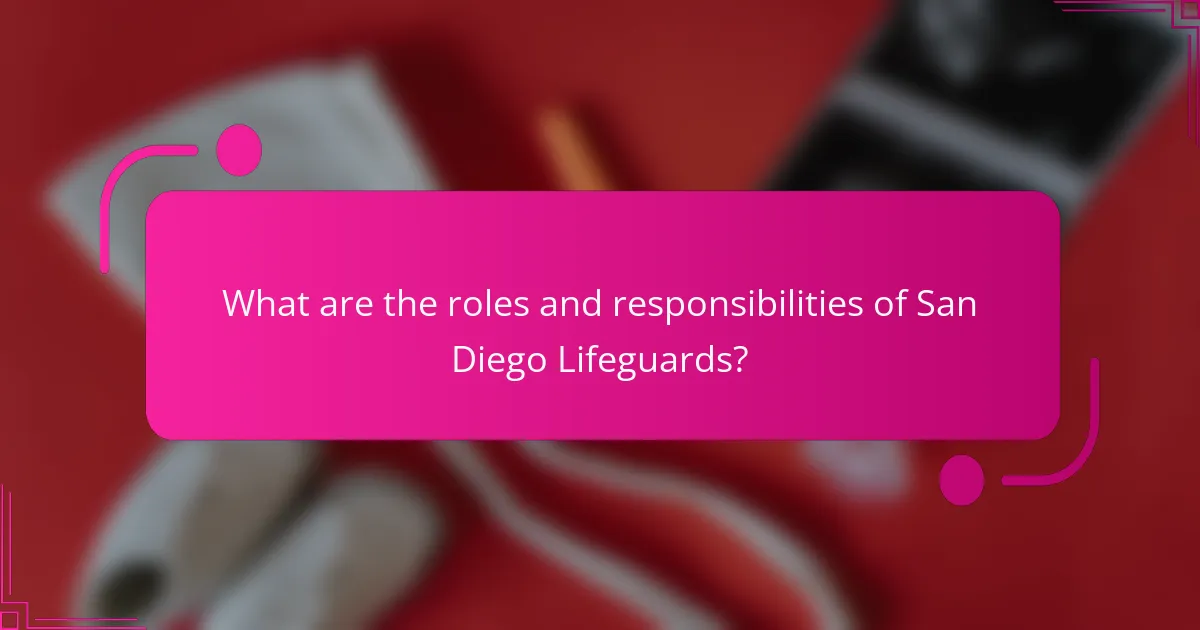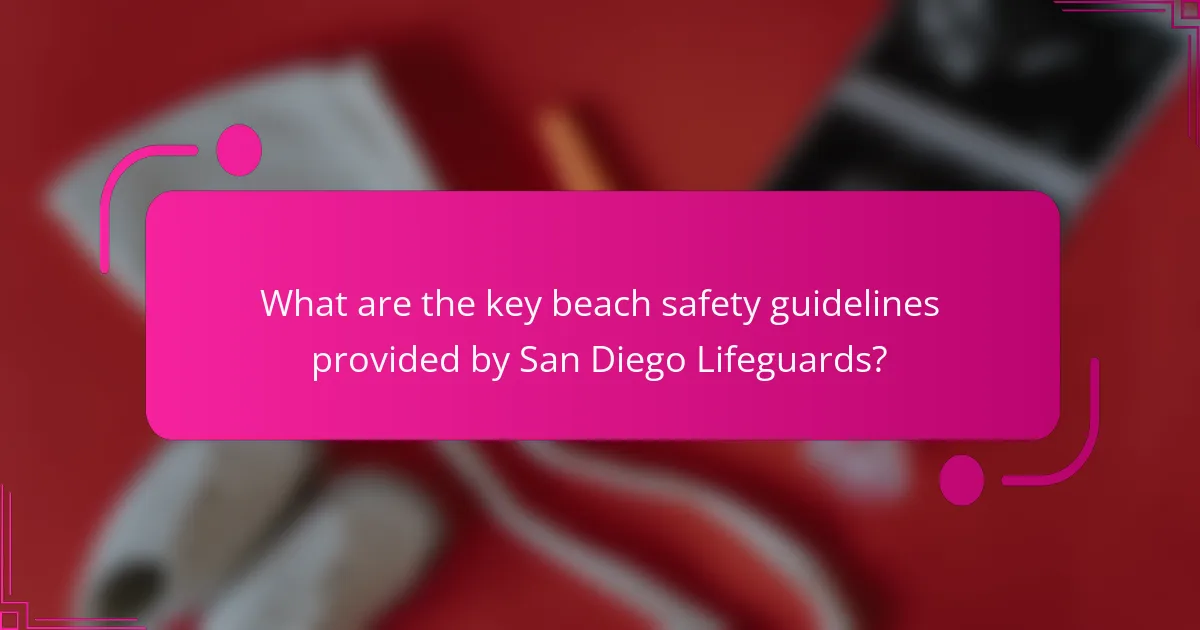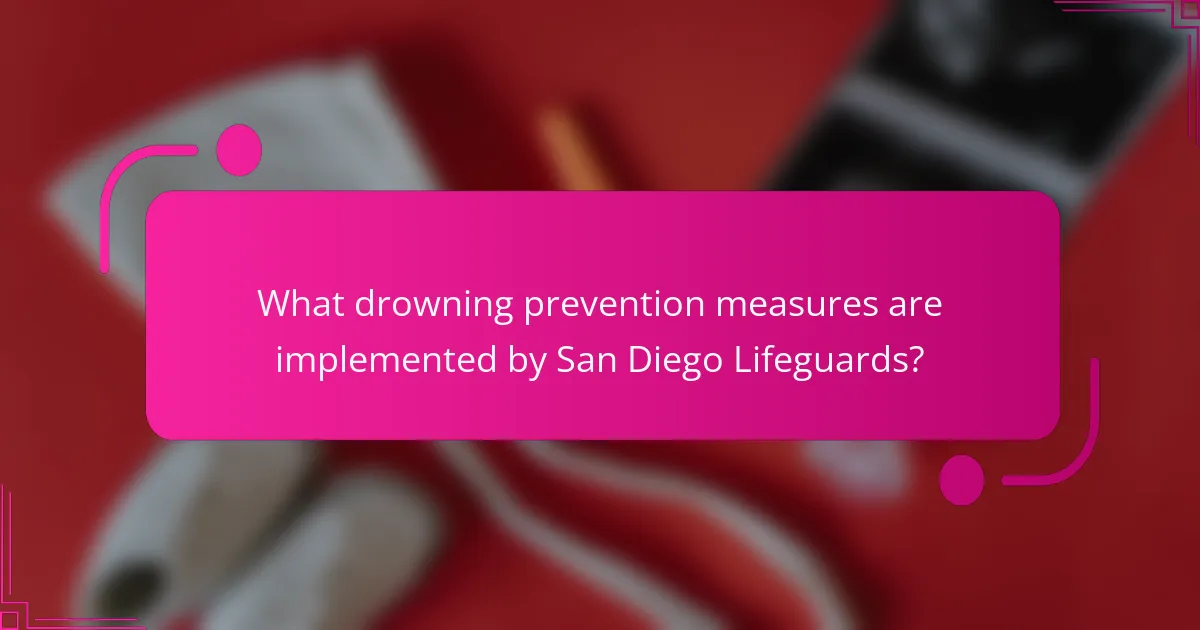
What are the roles and responsibilities of San Diego Lifeguards?
San Diego Lifeguards are responsible for ensuring the safety of beachgoers. They monitor beach conditions and enforce safety regulations. Lifeguards conduct rescues in emergencies and provide first aid when needed. They educate the public about ocean safety and potential hazards. Lifeguards perform regular surveillance of the water and beach area. They also participate in training and drills to maintain readiness. Furthermore, they collaborate with local agencies during emergencies. Their role is crucial in preventing drownings and promoting safe beach activities.
How do San Diego Lifeguards ensure beach safety?
San Diego Lifeguards ensure beach safety through active surveillance and emergency response. They monitor beachgoers from elevated towers. Lifeguards are trained to identify dangerous conditions, such as strong currents and rip tides. They provide safety briefings to educate the public about potential hazards. Lifeguards conduct regular drills to maintain readiness for emergencies. They also utilize rescue equipment, such as rescue boards and flotation devices. San Diego Lifeguards collaborate with local agencies for coordinated responses. Their efforts contribute to a significant reduction in drowning incidents along the coastline, with statistics showing a decrease in fatalities over recent years.
What training do lifeguards undergo to prepare for their duties?
Lifeguards undergo extensive training to prepare for their duties. This training includes swimming proficiency tests to ensure strong swimming skills. They learn rescue techniques for various emergencies, including drowning and spinal injuries. Lifeguards receive first aid and CPR training, which is critical in emergencies. They also study beach safety protocols and environmental hazards. Training often includes simulations of real-life rescue scenarios. Lifeguards must pass written exams to demonstrate their knowledge. This comprehensive training ensures lifeguards are equipped to protect beachgoers effectively.
What equipment do lifeguards use to maintain safety?
Lifeguards use various equipment to maintain safety at beaches. Essential items include rescue tubes, which are buoyant devices for assisting distressed swimmers. They also utilize rescue boards, which provide a stable platform for reaching individuals in trouble. Personal flotation devices (PFDs) are worn by lifeguards to ensure their safety while performing rescues. Additionally, first aid kits are crucial for treating injuries on-site. Whistles are used for signaling and alerting beachgoers to potential dangers. Lifeguards may also employ binoculars for surveillance of the water. These tools collectively enhance the lifeguards’ ability to respond effectively to emergencies.
What emergency protocols do San Diego Lifeguards follow?
San Diego Lifeguards follow established emergency protocols to ensure beach safety. These protocols include immediate response to water rescues, administering first aid, and calling for emergency medical services when necessary. Lifeguards are trained to assess situations quickly and effectively. They utilize rescue equipment such as flotation devices and rescue boards. Communication with other lifeguards is crucial during emergencies. Lifeguards also perform regular safety checks and monitor beach conditions. They educate beachgoers on safety practices to prevent incidents. These protocols are designed to minimize risks and enhance public safety at the beach.
How do lifeguards respond to drowning incidents?
Lifeguards respond to drowning incidents by immediately assessing the situation. They evaluate the victim’s condition and the surrounding environment. Lifeguards then enter the water if necessary, using rescue techniques to reach the individual. Once the victim is reached, they perform rescue procedures, which may include flotation devices. If the victim is unresponsive, lifeguards initiate CPR as per established protocols. They call for emergency medical services to provide further assistance. Lifeguards document the incident for reporting and review purposes. This structured response is crucial for effective drowning prevention and victim recovery.
What communication methods are used during emergencies?
Communication methods used during emergencies include radios, mobile phones, and public address systems. Radios allow lifeguards to communicate instantly with each other and emergency services. Mobile phones provide a reliable means to contact authorities and relay information. Public address systems help disseminate urgent messages to beachgoers. Visual signals, such as flags and signs, convey important safety information. These methods ensure quick and effective communication during critical situations. Accurate and timely communication can significantly enhance response efforts and save lives at the beach.

What are the key beach safety guidelines provided by San Diego Lifeguards?
San Diego Lifeguards emphasize several key beach safety guidelines. Always swim near a lifeguard station for immediate assistance. Pay attention to warning flags indicating water conditions. Avoid swimming alone to ensure safety in case of emergencies. Stay hydrated and use sunscreen to protect against sunburn. Be cautious of rip currents; swim parallel to the shore to escape them. Supervise children closely and ensure they wear life jackets if needed. Know the location of emergency equipment, such as flotation devices. Following these guidelines can significantly reduce the risk of accidents at the beach.
How can beachgoers stay safe while swimming?
Beachgoers can stay safe while swimming by following specific safety guidelines. Always swim in designated areas supervised by lifeguards. This ensures assistance is available in case of emergencies. Beachgoers should also check weather and water conditions before entering the water. Strong currents or rough waves can pose serious risks. Additionally, swimming with a buddy enhances safety, as help is readily available if needed. It is crucial to avoid swimming under the influence of alcohol or drugs, which impair judgment and reaction times. Wearing a life jacket is advisable, especially for inexperienced swimmers. Lastly, beachgoers should be aware of their swimming abilities and avoid pushing their limits in unfamiliar waters. These practices significantly reduce the risk of drowning and ensure a safer beach experience.
What are the dangers of rip currents and how can they be identified?
Rip currents pose significant dangers to swimmers. They can pull individuals away from the shore rapidly. This can lead to exhaustion and drowning if the swimmer is unable to escape. Rip currents can occur in any large body of water, especially near beaches.
Identification of rip currents involves observing certain characteristics. Look for water that is choppy and discolored compared to surrounding areas. Rip currents often appear as narrow, fast-moving channels of water heading away from the shore. Additionally, foam and debris may be visible moving seaward.
Understanding these signs can help individuals avoid dangerous situations. Lifeguards often monitor beaches for rip currents and can provide assistance. Awareness of these conditions is crucial for beach safety.
Why is it important to swim in designated areas?
Swimming in designated areas is crucial for safety. Designated areas are monitored by lifeguards. Lifeguards provide immediate assistance in emergencies. These areas are typically free of hazardous currents and obstacles. Swimming outside these zones increases the risk of drowning. According to the U.S. Coast Guard, most drowning incidents occur away from supervised locations. Designated areas also have clear signage and safety equipment. This promotes a safer environment for all swimmers.
What safety measures should families take at the beach?
Families should take several safety measures at the beach. First, always swim in designated areas supervised by lifeguards. This ensures immediate assistance in case of emergencies. Second, keep a close eye on children at all times. Drowning can occur quickly and silently. Third, use life jackets for non-swimmers or young children. Life jackets provide buoyancy and can prevent accidents. Fourth, check water conditions before swimming. Be aware of currents, tides, and weather changes. Fifth, establish a meeting point in case of separation. This helps families reunite quickly. Finally, apply sunscreen regularly to protect against sunburn. Skin damage can occur even on cloudy days. These measures significantly enhance safety and enjoyment at the beach.
How can parents ensure their children’s safety while swimming?
Parents can ensure their children’s safety while swimming by closely supervising them at all times. Constant vigilance helps prevent accidents and drowning incidents. Parents should also teach their children to swim and ensure they are aware of water safety rules. Using flotation devices can provide additional safety, particularly for younger children. It is essential to choose swimming areas that are monitored by lifeguards. Parents should also educate their children about the dangers of running near water and the importance of not swimming alone. Familiarizing children with the water environment can help build their confidence and safety awareness. According to the Centers for Disease Control and Prevention, drowning is a leading cause of unintentional injury death for children, highlighting the need for proactive safety measures.
What should beachgoers know about sun protection and hydration?
Beachgoers should apply sunscreen to protect their skin from harmful UV rays. Sunscreen with at least SPF 30 is recommended. It should be reapplied every two hours, especially after swimming or sweating. Wearing protective clothing and seeking shade during peak sun hours can further reduce sun exposure. Hydration is crucial to prevent dehydration in hot weather. Beachgoers should drink water regularly, even if they do not feel thirsty. The body loses fluids through sweat, and replenishing these fluids is essential. It is advised to consume at least 8 ounces of water every hour while at the beach.

What drowning prevention measures are implemented by San Diego Lifeguards?
San Diego Lifeguards implement various drowning prevention measures. They conduct regular beach safety education programs. These programs inform the public about rip currents and safe swimming practices. Lifeguards also patrol the beaches actively to monitor swimmers. They provide immediate rescue services when needed. Additionally, lifeguards use warning flags to indicate water conditions. They also employ signage to communicate safety information effectively. These measures aim to reduce drowning incidents and enhance overall beach safety.
What educational programs are available for drowning prevention?
Educational programs available for drowning prevention include swim education classes, water safety workshops, and CPR training sessions. Swim education classes teach children and adults essential swimming skills. Water safety workshops focus on recognizing hazards and safe practices around water. CPR training sessions equip individuals with life-saving techniques in emergencies. Organizations like the American Red Cross and local community centers often offer these programs. According to the Centers for Disease Control and Prevention (CDC), structured swim lessons can reduce the risk of drowning by 88% among children aged 1 to 4.
How do community outreach initiatives promote water safety?
Community outreach initiatives promote water safety by educating the public about risks and preventative measures. They provide essential information on safe swimming practices and local water conditions. Initiatives often include workshops, demonstrations, and distribution of educational materials. Programs may target schools, community centers, and local events to reach diverse audiences. According to the American Red Cross, educational outreach can reduce drowning incidents by informing individuals about safety protocols. Engaging the community fosters a culture of safety and encourages responsible behavior around water. These initiatives also often involve partnerships with local organizations to maximize their impact.
What resources are available for learning about swimming safety?
Resources for learning about swimming safety include organizations like the American Red Cross and the YMCA. The American Red Cross offers courses on water safety and lifeguarding. Their programs are designed to educate individuals on drowning prevention and safe swimming practices. The YMCA also provides swim lessons and safety courses for all ages. Additionally, local community centers may offer swimming safety workshops. Online platforms, such as the CDC, provide guidelines and tips for safe swimming. These resources are credible and widely recognized for promoting water safety.
What strategies can individuals use to prevent drowning?
Individuals can prevent drowning by following several key strategies. First, they should always swim in designated areas supervised by lifeguards. Lifeguards are trained professionals who monitor water safety. Second, individuals should never swim alone. Having a buddy increases safety during water activities. Third, wearing life jackets is crucial, especially for non-swimmers and children. Life jackets provide buoyancy and support in the water. Fourth, individuals should be aware of water conditions. Understanding currents, tides, and weather can help avoid dangerous situations. Fifth, taking swimming lessons enhances swimming skills and confidence. According to the Centers for Disease Control and Prevention, formal swimming lessons reduce the risk of drowning. Lastly, avoiding alcohol consumption while swimming or supervising others is essential. Alcohol impairs judgment and reaction times, increasing the risk of drowning.
How does swim training contribute to drowning prevention?
Swim training significantly contributes to drowning prevention by equipping individuals with essential water safety skills. It teaches participants how to float, tread water, and swim efficiently. These skills enhance a person’s ability to stay safe in water. According to the Centers for Disease Control and Prevention (CDC), formal swim lessons can reduce the risk of drowning by 88% in children aged one to four. Swim training also promotes awareness of water conditions and potential hazards. This awareness helps individuals make informed decisions while swimming. Furthermore, trained swimmers are more likely to assist others in distress, fostering a safer aquatic environment. Overall, swim training is a crucial intervention for reducing drowning incidents.
What are the best practices for supervising children at the beach?
The best practices for supervising children at the beach include maintaining constant visual contact. Parents or guardians should stay within arm’s reach of young children. Designated swimming areas should be adhered to, as they are typically monitored by lifeguards. It is important to set specific boundaries for where children can play. Regular headcounts should be conducted to ensure all children are present. Use of flotation devices is recommended, but they should not replace [censured] supervision. Educating children about water safety and potential hazards is essential. These practices are supported by lifeguard training programs emphasizing the importance of vigilance and proactive supervision.
What practical tips can beachgoers follow to enhance safety?
Beachgoers should follow several practical tips to enhance safety. Always swim in designated areas supervised by lifeguards. Be aware of local weather conditions and tides before entering the water. Use sunscreen to protect against UV rays and reapply every two hours. Stay hydrated by drinking plenty of water, especially on hot days. Keep a close eye on children and ensure they wear life jackets if necessary. Avoid alcohol consumption while swimming or supervising others. Familiarize yourself with rip current safety and how to escape them. Lastly, know the emergency contact numbers for local lifeguards and medical services. These measures significantly reduce risks and ensure a safer beach experience.
San Diego Lifeguards play a critical role in ensuring beach safety by monitoring conditions, enforcing regulations, conducting rescues, and providing first aid. This article outlines their responsibilities, including emergency response protocols, training requirements, and the equipment they use to maintain safety. Key safety guidelines for beachgoers, strategies for drowning prevention, and educational resources for water safety are also discussed, emphasizing the importance of vigilance and adherence to safety practices at the beach. Understanding these measures can significantly reduce the risk of drowning and enhance the overall safety of beach activities.